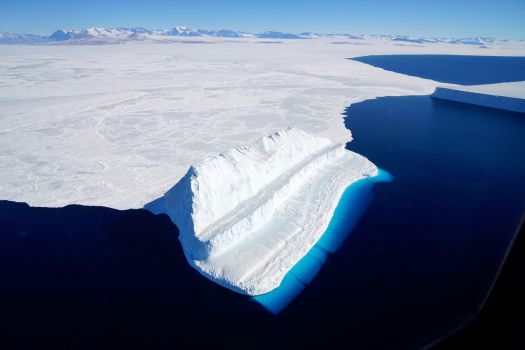The warmer it gets; the faster Antarctica loses ice – and much of it will then be gone forever. Consequences for the world’s coastal cities and cultural heritage sites would be detrimental, from London to Mumbai, and from New York to Shanghai.

That’s what a team of researchers from the Potsdam Institute for Climate Impact Research, Potsdam University and New York’s Columbia University has found out in their new study, published in Nature, on how much warming the Antarctic Ice Sheet can survive.
In around one million hours of computation time, their unprecedentedly detailed simulations delineate where exactly and at which warming levels the ice would become unstable and eventually melt and drain into the ocean. They find a delicate concert of accelerating and moderating effects, but the main conclusion is that unmitigated climate change would have dire long-term consequences: If the global mean temperature level is sustained long enough at 4 degrees above pre-industrial levels, Antarctic melting alone could eventually raise global sea levels by more than six meters.
“Antarctica holds more than half of Earth’s fresh water, frozen in a vast ice-sheet which is nearly 5 kilometres thick,” explains Ricarda Winkelmann, researcher at the Potsdam Institute for Climate Impact Research (PIK) and University of Potsdam, and corresponding author of the study. “As the surrounding ocean water and atmosphere warm due to human greenhouse-gas emissions, the white cap on the South Pole loses mass and eventually becomes unstable. Because of its sheer magnitude, Antarctica’s potential for sea-level contribution is enormous: We find that already at 2 degrees of warming, melting and the accelerated ice flow into the ocean will, eventually, entail 2.5 meters of global sea level rise just from Antarctica alone. At 4 degrees, it will be 6.5 meters and at 6 degrees almost 12 meters if these temperature levels would be sustained long enough.”
Long-term change: it’s not rapid, but it’s forever
The paper’s title refers to the complex physical phenomenon of hysteresis. In this case, that translates into irreversibility. Anders Levermann, co-author and researcher at PIK and Columbia University, describes: “Antarctica is basically our ultimate heritage from an earlier time in Earth’s history. It’s been around for roughly 34 million years. Now our simulations show that once it’s melted, it does not regrow to its initial state even if temperatures eventually sank again. Indeed, temperatures would have to go back to pre-industrial levels to allow its full recovery – a highly unlikely scenario. In other words: What we lose of Antarctica now, is lost forever.”
The reasons behind this irreversibility are self-enforcing mechanisms in the ice sheets’ behaviour under warming conditions. Co-author Torsten Albrecht lays out: “In West Antarctica for instance, the main driver of ice loss is warm ocean water leading to higher melting underneath the ice shelves, which in turn can destabilize the grounded ice sheet. That makes glaciers the size of Florida slide into the ocean. Once temperatures cross the threshold of six degrees above pre-industrial levels, effects from the ice surface become more dominant: As the gigantic mountains of ice slowly sink to lower heights where the air is warmer, this leads to more melt at the ice surface – just as we observe in Greenland.”
The fate of New York, Tokyo, Hamburg is in our hands
Ice loss and melting have accelerated significantly over the last decades in Antarctica. The authors however have explicitly not addressed the question of time scale in their work, but rather assess the critical warming levels at which parts of the Antarctic Ice Sheet become unstable. Winkelmann explains this approach: “In the end, it is our burning of coal and oil that determines ongoing and future greenhouse-gas emissions and therefore, if and when critical temperature thresholds in Antarctica are crossed.
And even if the ice loss happens on long time scales, the respective carbon dioxide levels can already be reached soon. We decide now whether we manage to halt the warming. So, Antarctica’s fate really lies in our hands – and with it that of our cities and cultural sites across the globe, from Rio de Janeiro’s Copacabana to Sydney’s Opera House. Thus, this study really is another exclamation mark behind the importance of the Paris Climate Accord: Keep global warming below two degrees.”
Levermann adds: “If we give up the Paris Agreement, we give up Hamburg, Tokyo and New York.”
